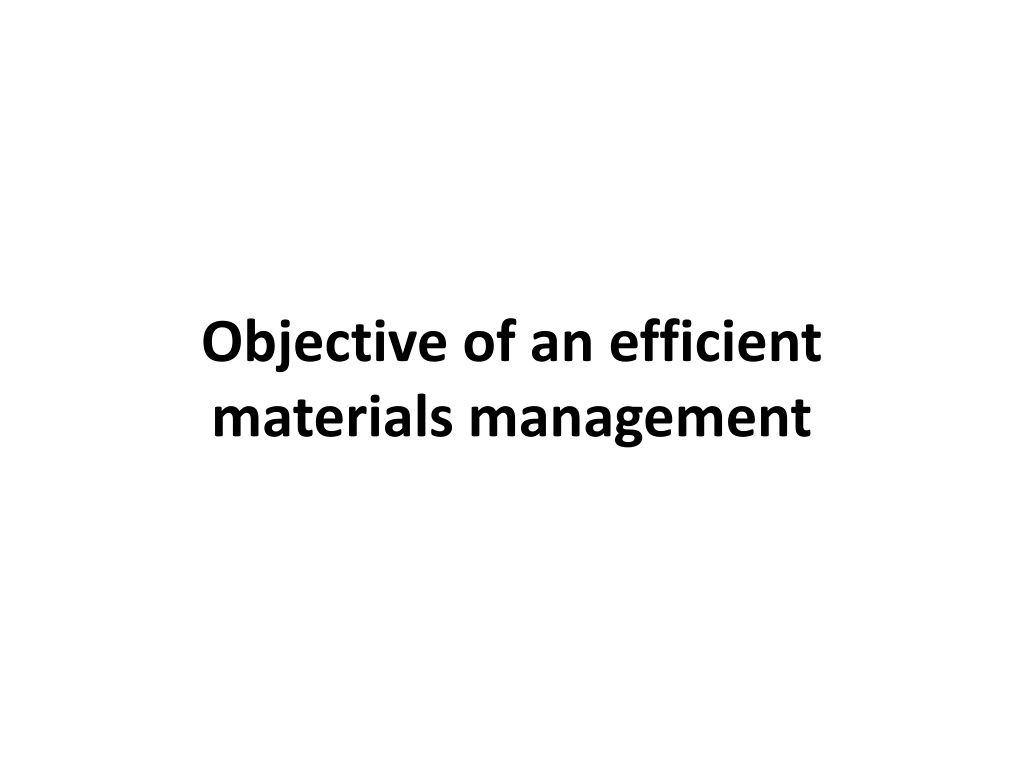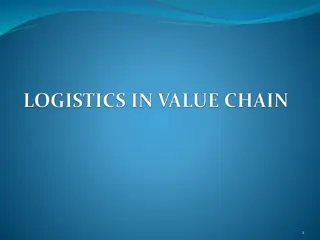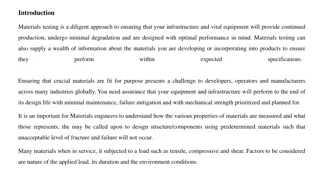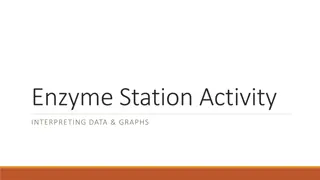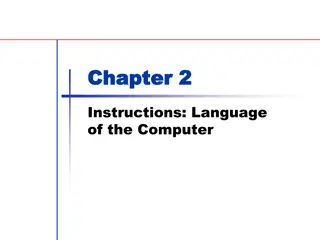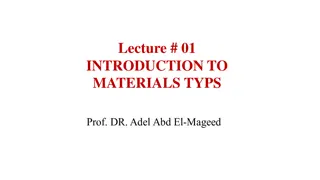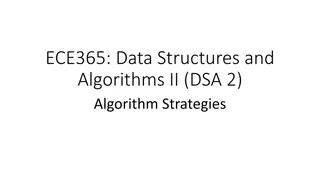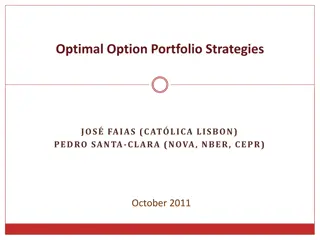Efficient Materials Management Strategies for Optimal Operations
Efficient materials management aims to ensure the right materials are available at the right place, time, quantity, and quality. It involves stages such as precise objective definition, specification of requirements, and measurement of performance. Factors influencing materials management include technology, market trends, and regulations. Clarifying requirements, determining procurement opportunities, and addressing storage strategies are critical aspects for successful materials management.
Uploaded on Sep 28, 2024 | 0 Views
Download Presentation

Please find below an Image/Link to download the presentation.
The content on the website is provided AS IS for your information and personal use only. It may not be sold, licensed, or shared on other websites without obtaining consent from the author. Download presentation by click this link. If you encounter any issues during the download, it is possible that the publisher has removed the file from their server.
E N D
Presentation Transcript
Objective of an efficient materials management
The objective of an efficient materials management is to provide the right materials (tools, work tools, spare parts, supplies) at the right time at the right place in the right amount and the right quality. Measure of effectiveness The materials management must subordinate all acts to economic efficiency! Measure of efficiency
The stages on the way to efficient materials management Aim 4. Measurement of performance 3. Choice of methods and instruments 2. Specification of requirements 1. Precise definition of objectives Starting point
Specification of requirements Concrete order requisition Organization Storage strategies Defined availability Minimal costs Storage locations Storage quantity Procurement strategies Specified quality requirement
Influencing factors Technology Market Regulations determine Maintenance requirements determines Maintenance strategy determines Requirements for the maintenance materials management
Clarification of requirements and definition of the design Implementation of an plant structuration - with identification of risks - and determination of reaction times What is needed where and how fast do i need it? Determination of value and consumption frequency Determination of procurement opportunities How is it most favourable to provide?
The principal issues of an efficient materials management Stock storage or order if required? Where is to be stored? What are the safety stocks? When is the order initiation? How big should be the procurement quantities?
Determinants of storage strategy Reaction times Procurement costs Procurement market Store or order if required? Contribution margins Buffer capacities Storage possibilities Storage costs Consumption pattern Standards
Assessment of production losses Prerequisites: No personal injury, no environmental- or product damage and no damage to the system caused by the loss of production Assessment of risk of customer loss Which contribution margins can escape us? What storage costs we save? - Revenues minus variable costs, taking into acount existing buffer capacities -Cost of storage bins and warehouse management - Imputed Interest -Possibly calculatory depreciation + - Decisions by comparison of contribution margins and inventory costs
Storage locations Central warehouse -Low administrative costs -Lower storage amount -Higher inventory turnover -Higher utilization Decentralized storage -Short transport routes -Short transportation times In any case a central warehouse management system Fundamentally a central warehouse due to lower costs For material with low value for regularly recurring activities (usually operating materials and working aids) hand bearings close by the respective point of use are justifiable
Importance of stock materials Determination of the importance of stock materials based on the ABC-analysis Procedure 1. Determination of the annual consumption value (the product of value and consumption frequency) of the stock materials 2. Sorting of the material in descending order by annual consumption value 3. Determination of the cumulative annual consumption values 4. Drawing of reasonable limits 10-15% of the materials 70-80% of the value A-materials 30-40% of the materials 15-20% of the value B-materials 50-60% of the materials 5-10% of the value C-materials Concentration of effort on A-materials, referring to optimal inventory levels and inventory tracking
Example of an ABC-analysis Material Consumption value Cumulated share of the number of materials[%] Cumulated share of consumption value[%] Classific ation 4 580 10,0 48,54 A 7 250 20,0 69,46 A 2 160 30,0 82,85 B 10 100 40,0 91,21 B 6 30 50,0 93,72 C 8 25 60,0 95,82 C 5 20 70,0 97,49 C 9 15 80,0 98,74 C 1 10 90,0 99,58 C 3 5 100,0 100,00 C
5 9 1 3 8 100 6 10 90 2 Cumulated share of consumption value 80 7 70 60 4 50 40 30 20 10 0 0 10 20 30 40 50 60 70 80 90 100 Cumulated share of the number of materials
Determination of ordering times stock Regular Consumption consumption curve incoming goods order Reorder point Safety stock level t Replenishment time Buffer
Sporadic consumption - Predictable time of need Order at the time of need - Random time of need Storage strategy in consideration of efficiency
Order quantity Large quantities offer price advantages through high discounts mean lower specific transport costs lead to low specific ordering costs lead to high storage costs represent a high capital commitment (and high imputed interest on the average stock) increse the risk of technical obsolescence of inverntories because of the low stock turnover Small quantities behave exactly reverse
Determination of the optimal order quantity Example -Value per piece 100 -Annual requirement 100 pieces -Constant consumption -Order costs 30 -Transport costs 100 -Storage space 100 / year -Imputed interest rate 10 % Order quantity Order value Order costs / year Transport costs / year Storage costs / year Capital costs / year Total costs / year 1 100 3000 10000 50 5 13055 3 300 1000 3333 150 15 4498 5 500 600 2000 250 25 2875 10 1000 300 1000 500 50 1850 15 1500 200 667 750 75 1692 25 2500 120 400 1250 125 1895 50 5000 60 200 2500 250 3010 100 10000 30 100 5000 500 5630 Economic order quantity
Graphical determination of the optimal order quantity 3500 Total costs / year 3000 Order- and transport costs Storage- and capital costs 2500 costs 2000 Optimum 1500 1000 500 0 5 6 7 8 9 10 11 12 13 14 15 16 17 18 19 20 21 22 23 24 25 order quantity
Potentials to reduce costs in materials management Check requirements to maintenance due to market requirements periodically and orientate the materials management towards the requirements Check online-order opportunities with fixed delivery promises Conduct regular inventory analysis with professional warehouse management systems Consider potentials from the standardization already at the construction of new plants
Conclusion An efficient design of materials management in maintenance is possible only under the following principles: The assessment of efficiency is possible only under definition and considerations of the objectives The objectives result from the requirements of the primary process (Production). Market, technology and regulations determine the maintenance strategy The maintenance strategy determines the requirements to the materials management. Without knowledge or specification of the strategy no efficient materials management! As market conditions change dynamically, the materials management must be reviewed regularly in terms of their effectiveness and efficiency
